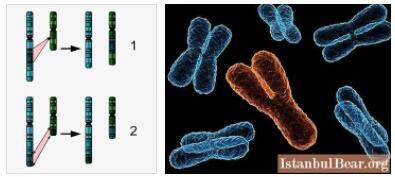Chromosomal aberrations are characterized by numerical or structural changes in chromosomes. These are genetic defects that can be made visible through chromosome examinations and affect several genes. Because of the considerable genetic changes, many chromosome aberrations are incompatible with life.
What are chromosome aberrations?
Chromosomal aberrations are genetic changes that affect a large area of genetic material. On the one hand there are numerical and on the other hand structural changes to the chromosomes. The numerical chromosome aberrations are characterized either by the loss or the excess number of chromosomes.
The human genome consists of 23 pairs of chromosomes, with 22 pairs of chromosomes containing autosomes (chromosomes that do not determine the sex). The 23rd chromosome pair contains the sex chromosomes X and Y. The X chromosome represents the female and the Y chromosome the male sex chromosomes. With the numerical chromosomal aberrations of the autosomes, only a few trisomies (3 instead of 2 chromosomes) are compatible with life.
Monosomies (one chromosome instead of two chromosomes) in the autosomes cannot develop a viable organism. In the case of sex chromosomes, in addition to trisomies, monosomy with the X chromosome is also viable. In addition to the numerical chromosome aberrations, there are also structural chromosome changes. This can lead to deletions, inversions or translocations, for example.
Deletions represent shortenings of chromosome sections with loss of genetic information. In the case of inversions, broken chromosome parts are put together the other way round. Translocations are characterized by the shifting of chromosome segments to other locations in the genetic material. This can also happen across chromosomes.
Causes
The causes of chromosome aberrations are manifold. Numerical chromosome changes are caused by errors during cell division. It can happen that during meiosis the two chromosomes of a chromosome set stay together. Since germ cells arise in meiosis by halving the chromosome set, if the division is incorrect, one germ cell (gamete) has a complete pair of chromosomes and the other no chromosomes of the chromosome type concerned.
If one of these gametes (egg cell or sperm) fuses with a normal gamete during fertilization, either a trisomy or a monosomy occurs. With the exception of the X monosomy, all monosomies are incompatible with life. However, some trisomies are viable. In the case of numerical chromosome aberrations, there can theoretically also be more than three chromosomes in a chromosome set.
Structural chromosome aberrations are mostly caused by breaks in chromosomes caused by the action of chemical substances, radiation and other influences. The broken individual pieces are then put together incorrectly if the repair system also works incorrectly. Fragments are lost and the corresponding chromosome is shortened (deletion). Or the fragments are put together the wrong way round (inversion).
Fragments or even whole chromosomes can also be attached to other chromosomes. If all hereditary information has been preserved, it is a balanced translocation. The person concerned is completely healthy. However, his offspring can then suffer from a so-called translocation trisomy. They have the normal set of chromosomes and also a rearranged chromosome. Symptoms of translocation trisomy are similar to those of normal trisomy.
Symptoms, ailments & signs
The symptoms of chromosomal aberration depend on the type of disorder. The best-known trisomy is the so-called Down syndrome. In Down syndrome, chromosome 21 is present three times. It is irrelevant whether a normal trisomy or a translocation trisomy is present.
Down’s syndrome is characterized by the characteristic mongoloid lid axis position, heart defects or muscle hypotonia. The mental retardation can often be influenced by intensive support. Life expectancy is 50 to 60 years. Trisomy 13 (Patau syndrome) and trisomy 18 (Edward ‘s syndrome) are also known. Both syndromes lead to death in early childhood.
With the exception of X monosomy (Ullrich-Turner syndrome), numerical gonosomal chromosomal aberrations (sex chromosomes) are often discovered by chance because the symptoms are mild. When Klinefelter syndrome associated with the constellation XXY eunuchoid falls tall stature, delayed puberty, infertility and female habit. The IQ is mostly normal.
XXX women and XYY men are usually normal, so that these trisomies are almost always an incidental finding. The best known of the structural chromosome aberrations are Cri-du-Cat syndrome (deletion in the short arm of chromosome 5) and Wolf-Hirschhorn syndrome (deletion in the short arm of chromosome 4). Both syndromes are associated with severe physical and mental disabilities.
Diagnosis
Chromosome aberrations are diagnosed by displaying and evaluating karyograms. To produce a karyogram, the cells are stimulated to divide and at the same time treated with the cytotoxin colchicine to hold the divided chromosomes together.
The chromosomes thus determined are then viewed under a microscope and photographed. There is a typical band pattern through which chromosome changes can be clearly recognized.
Complications
The chromosome aberrations can lead to different genetic defects and malformations in the patient. In most cases, those affected suffer from what is known as Down’s syndrome. Most of the syndromes burden the patient with severe malformations. This primarily leads to a heart defect and mental retardation.
The patient’s intelligence is greatly reduced, although this can be influenced by therapies and other learning methods. Because of the heart defect, life expectancy drops to around 60 years. Often the patients also suffer from short stature and other malformations that can affect the face or extremities.
It is not uncommon for the malformations to lead to psychological complaints or depression. The sexual development of those affected is also delayed or only to a very limited extent due to the chromosome aberrations. It is not possible to treat chromosomal aberrations causally. The patient must live with the symptoms of the particular syndrome their entire life.
However, many of them can be restricted and treated so that everyday life becomes bearable for the patient. Which measures are necessary for the treatment and whether there may be complications depends to a large extent on the genetic defect and the respective measure.
When should you go to the doctor?
In the case of chromosome aberrations, visits to the doctor depend very much on the severity and nature of the symptoms. Unfortunately, in many cases with chromosomal aberrations, patients cannot survive and die shortly after birth. In this case, a psychologist should also be consulted if the parents and relatives suffer from psychological problems. As a rule, patients with this disease are dependent on regular examinations of all organs and body functions.
The heart in particular needs to be examined regularly. A visit to the doctor is also necessary if the person concerned suffers from mental retardation due to chromosome aberrations. The patient is dependent on special support.
As a rule, the diagnosis can be made by a general practitioner or a pediatrician. Further treatment depends on the extent of the symptoms and usually takes place with the respective specialist. If the child also suffers from psychological complaints, treatment should also take place with a psychologist.
Treatment & Therapy
The treatment of diseases and syndromes that are caused by chromosome aberrations is always symptomatic. A causal treatment is excluded. Some syndromes can be managed well with accompanying support. This includes Down syndrome.
Both mental development and the treatment of physical impairments often depend on the support measures introduced and the overall treatment concept.
Outlook & forecast
The prognosis for chromosomal aberrations is poor, as a cure is not possible. However, they are essentially dependent on the disorders present, which show up individually for each patient. In most patients, chromosomal aberrations are associated with a significant reduction in average life expectancy.
Since an intervention in human genetics is not legally permitted, no causal therapy and thus a change in the genetic mutations can take place. Treatment is aimed at relieving the patient’s existing symptoms. In addition, doctors try to delay the progression of the disease for as long as possible with targeted therapies.
The chromosome aberrations are associated with numerous malformations or cognitive losses. In addition, there are restrictions on development and sexual functions. In addition to the physical abnormalities, the chromosome aberrations can lead to numerous mental illnesses. This further reduces the quality of life of the patient and worsens the overall health of the patient. When offspring are produced, the chromosomal aberrations can be passed on to the next generation. There is a possibility that the symptoms will be reduced or increased.
In the case of syndromes that have been well researched, there is a possibility of a significant improvement in living conditions. Support measures as well as an individual treatment concept are used, which represent better development opportunities for the patient.
Prevention
As a prophylaxis against diseases caused by chromosome aberrations in the offspring, intensive human genetic counseling should be carried out if cases of disease have already occurred within the family or relatives. Usually these syndromes arise spontaneously. However, a translocation trisomy has a certain probability of inheritance. A frequent familial occurrence is possible, which should be clarified in terms of human genetics.
Aftercare
In most cases, the affected person has no or only very few follow-up measures available for chromosomal aberrations. Since it is a genetic disease, it cannot be fully treated either. Therefore, if you want to have children, genetic testing and counseling should always be carried out so that chromosome aberrations do not occur in the children.
Further treatment depends very much on the exact severity of the disease, so that no general prediction can be made. The life expectancy of the person affected may also be reduced. In most cases, the treatment itself takes the form of surgical interventions, which are intended to alleviate the malformations and deformities. After such an operation, the person affected should rest and take care of their body.
Exertion and stressful or physical activities should be avoided in any case. Likewise, most of those affected by the chromosome aberrations are also dependent on the help and support of their own family in order to cope with everyday life. In doing so, intensive and loving discussions are often necessary so that there are no psychological upsets or depression.
You can do that yourself
The possibilities of self-help are relatively limited in the case of chromosome aberrations. The affected person is dependent on purely symptomatic therapy, since the disease cannot be treated causally. Chromosomal aberrations often lead to premature death of the person concerned.
People who suffer from chromosome aberrations require intensive care and often cannot cope with everyday life on their own. Here, care by one’s own family or friends proves to be very useful and has a positive effect on the course of the disease. The children also need a special school education because they suffer from reduced intelligence. However, the exact treatment depends very much on the exact disease, so that no general predictions can be made here.
Often the contact with other people can also prove to be very helpful, as it can lead to an exchange of information. In the case of psychological complaints or depression, talking to friends and family can help. However, they are not a substitute for a psychologist, so a doctor must be consulted in the event of serious complaints. The parents and relatives of the patient often suffer from psychological complaints due to chromosome aberrations and are dependent on a visit to a psychologist.



